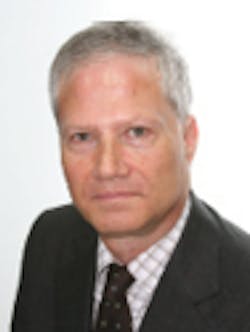Jeremy Beckman London
Salt slowing output from southern fields
Some UK southern North Sea (SNS) operators may be underestimating the impact of salt on their gas production, according to Britain’s Oil & Gas Authority (OGA). Last year it conducted a study on salt build-up in wells in the area, with the participation of seven local operators. The results suggest at least one-fifth of SNS wells are likely to experience salt deposition, with a limited consistency among the operators on the correct mitigation approach.
The OGA’s 2016 stewardship survey found that production efficiency in the SNS, at around 64%, was the lowest across the UK continental shelf, with production losses from fields in the area of 130 MMcf/d attributable to salting. Over half of the reviewed wells hit by salting were in Permian age fields, followed by Carboniferous fields which typically have higher salt concentrations in their formation water.
Salt build-up /blockages in topsides equipment in the UK southern North Sea. (Courtesy Perenco UK/Oil & Gas Authority)
Two of the main mechanisms for salt-deposition in producing wells are a) gas stripping fresh water from the produced formation water at reduced pressures, which increases brine salinity; and b) a decrease in halite solubility at reduced temperatures and pressures, mainly encountered in wells with a high water/gas ratio.
The operators surveyed diagnosed the problem primarily through analyzing well performance (rate, temperature, pressure), followed by infrequent wireline, camera and sampling surveys. The OGA’s findings suggest there is an opportunity for SNS companies to improve management of salt issues through using established techniques and software to predict salt deposition, and through more regular and frequent produced water sampling for salinity (a procedure apparently constrained on not normally manned platforms in the area due to limited access).
In the Dutch sector, the government entity EBN and research organization TNO have been more proactive in addressing the problems, and the OGA is now looking to develop synergies between the two sectors on salt/halite management.
Advanced jackup starts work on Gullfaks
KCA Deutag has started drilling operations for Statoil on the Gullfaks field in the Norwegian North Sea. This is the first assignment for the newbuild Cat J jackupAskeladden, which was commissioned by Statoil and its co-licensees for long-term production and exploratory drilling on the Gullfaks Satellites. The goal is to extend the productive live of the Gullfaks complex.
The rig will drill 11 wells during its first two years of operation, initially plugging existing wells with the spare slots then re-used to drill new targets. One of the planned new wells will be sidetracked into the Rimfaks Lonvi prospect to explore for new hydrocarbon deposits. According to the rig’s drilling superintendent Carlos Kauffman it is designed for “a digitalized future and can start using almost any new technology.”
It also has a subsea BOP, not common on jackup rigs, and this should improve the efficiency of drilling operations as it lessens the need to wait on weather changes. “Our challenge,” he added, will be to utilize the weather windows properly and avoid moving the rig in the winter season.” Sister jackup Askepott is performing development drilling from Statoil’s new Oseberg Vestflanken 2 platform.
Barryroe field location offshore southern Ireland. (Map courtesy Providence Resources)
Chinese group steps into Barryroe
Providence Resources has attracted Chinese partners to its appraisal drilling program for the Barryroe oil discovery in the North Celtic Sea basin 50 km (31 mi) offshore southern Ireland. The arrangement could finally spur development of the field, originally discovered by Esso in the 1970s, which is thought to hold 266 MMbbl of recoverable oil, with 187 bcf of associated gas.
APEC, which has agreed to take a 50% interest in the surrounding exploration license SEL 1/11 (pending approvals), is a privately owned Chinese company that in partnership with China Oilfield Services Co (COSL) and JUC Capital Management invests in and develops promising offshore opportunities using Chinese drilling rigs, services and equipment. These would undertake the proposed three-well/testing campaign on Barryroe, to be operated by Providence subsidiary EXOLA, with APEC retaining the right to become operator for the development.
The field contains 43°API oil with a wax content in the range 17-20%, with hydrocarbons proven in Cretaceous Middle and Lower Wealden reservoir sands. There is thought to be further potential in stacked Lower Wealden and Purbeckian sandstones, but further drilling would be needed to confirm this. Providence is also in talks on a farm-out of equity in the deepwater FEL 6/14 license offshore southwest Ireland, where the company and partner Sosina hope to drill the Newgrange prospect. Discussions are under way with other nearby operators on a potential area-wide drilling program.
Robot to work with crew on Alwyn
Total has agreed to trial an autonomous ground robot for inspections on its Alwyn platform in the UK northern North Sea. This is currently undergoing further development by the UK’ Oil & Gas Technology Centre, Austrian company taurob, and Technische Universitat Darmstadt in Germany. The university and taurob teamed up to win Total’s 2017 ARGOS (Autonomous Robots for Gas and Oil Sites) competition, the assignment being to produce an autonomous robot that could undertake routine tasks and respond to challenges in a simulated operational oil and gas environment.
The robot is ATEX-certified, allowing it to work in gas environments without the risk of ignition, and can perform visual inspections of dials, level gauges and valve positions. It can also navigate through narrow spaces and up/down stairs, measure temperature and gas concentrations, and detect/avoid obstacles or humans. The project will deliver two further versions with a focus on improved reliability and functionality, and operable by personnel offshore without the need for support from on-site robotics technicians. Total sees potential benefits in terms of operations safety and cost optimization.








